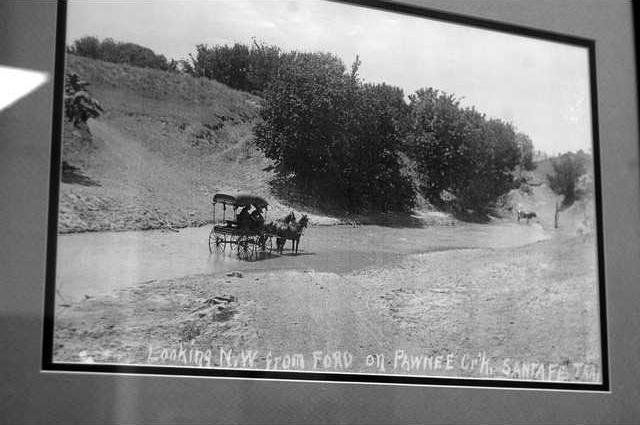By David K. Clapsaddle
Editor’s Note: Local historian David Clapsaddle writes about aspects about the Santa Fe Trail. The early years before trading on the Santa Fe Trail eventually included Fort Larned and Pawnee County. The 14th installment profiled the Ash Creek area in Pawnee County.
Pawnee River
Six miles beyond Ash Creek, still in present Pawnee County, was the Pawnee River, commonly called Pawnee Fork for its tributarial relationship to the Arkansas River.
Just west of the crossing, Samuel Parker established a ranch in 1864. In the subsequent year, he opened a second ranch upstream on the Pawnee at the Dry Route Crossing of the Santa Fe Trail. The ranch changed hands several times before being purchased by a man known only as Wagginer.
In 1867, Indians raided the ranch, running off the livestock, and burning the buildings. Thinking discretion to be the better part of valor, Wagginer sold the ranch to Albert Henry Boyd and left for safer quarters.
Boyd, discharged from an Illinois volunteer regiment, came to Kansas in 1864 where he found employment at Fort Leavenworth before becoming engaged in a number of freighting expeditions to Colorado and Santa Fe. During the trip to Santa Fe, he became acquainted with Fort Dodge, where in 1866 he was employed by the wood contractor.
In 1867, he moved to Fort Larned and secured the wood contract. In the following year he purchased the ranch. Boyd set up living quarters in a dugout while he began construction of a sod house 50 feet wide, 100 feet long.
All the outbuildings, except the frame chicken house, were made of sod. Even the corral was constructed of sod, four feet high. From the ranch, Boyd conducted several business ventures. Selling provisions to buffalo hunters, he, in turn, became a dealer in hides and furs at Boyd’s Ranch.
In addition, he established a freighting business hauling goods from both Ellsworth and Hays City to Fort Larned and Fort Dodge. He also secured hay and wood contracts at Fort Larned and engaged in cattle trading. Another investment was the toll bridge built across the Pawnee. Unfortunately, flood water destroyed the bridge in 1869.
The Boyd Ranch, located just outside the Fort Larned Military Reservation, catered to both civilians and soldiers. Liquor was dispensed in abundance, and there is ample evidence to suggest that Boyd also dealt in the oldest commodity known to men.
While the Boyd Ranch did not suffer the same fate as did the other trading establishments east of Walnut Creek which were closed by the westward expansion of the Union Pacific Railway, Eastern Division, a similar death knell was sounded for Boyd’s business in 1872 with the arrival of the Atchison, Topeka and Santa Fe Railroad and the establishment of the City of Larned.
Moving quickly to meet the challenge of a more civilized society, Boyd turned the ranch into a working farm and built a hotel in the infant town of Larned. Early in 1873, he moved to Dodge City where, in partnership with George B. Cox, he opened the celebrated Dodge House.
As to Samuel Parker, his original ranch was still in operation on Feb. 28, 1867, when a small party of Cheyennes arrived on scene and ordered him to cook supper for them.
When they discovered he had no sugar to give them, they threatened to kill him. Like Wagginer, Parker soon left for safer quarters.
Beyond Pawnee Fork, three stage stations were established: one at the Big Coon Creek crossing, 25 miles southwest of Fort Larned; one at the future site of Fort Dodge called Atkin’s Ranch; and the third at the old Fort Atkison.
Further west, Robert Wright supervised the construction of seven stage stations on the Bent’s Fort Road (Mountain Branch). The locations of most of the stations remain unknown, but one was situated at Pretty Encampment, a popular campsite east of Sand Creek.
None of the stations could be characterized as trading establishments.
(To Be Continued)
Boyd's Ranch established at Pawnee River




